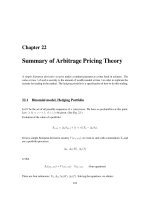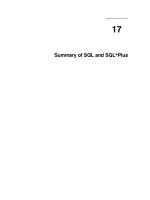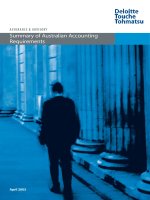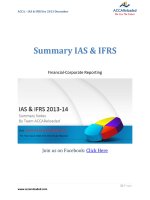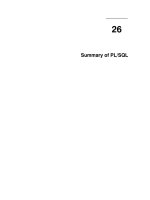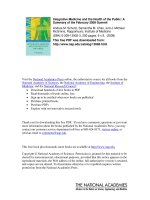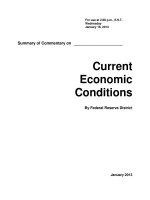Summary of key provisions of IAS & IFRS
Bạn đang xem bản rút gọn của tài liệu. Xem và tải ngay bản đầy đủ của tài liệu tại đây (79.21 KB, 7 trang )
1
Tony Sweetman – Kaplan Publishing
& Kaplan Financial Dec 11
Summary of key provisions of IAS & IFRS which may be relevant to ACCA
financial reporting and audit papers for 2012 examinations
2010 Conceptual Framework for Financial Reporting
Objectives:
Meets the needs of a range of users
Financial performance as per SOCI
Financial position as per SOFP
reporting entity:
Separate legal entity
Commercial substance of corporate group
qualitative characteristics:
fundamental characteristics of relevance and faithful representation
enhancing characteristics of comparability, verifiability, timeliness and understandability
elements of financial statements:
Assets – rights to future economic benefits as a result of a past transaction or event
Liabilities – future obligations to transfer economic benefits as a result of a past
transaction or event
Equity – residual interest in an entity’s assets after deduction of all liabilities
Income – the increase in economic benefits during an accounting period
Expenses – decreases in economic benefits during an accounting period
recognition in financial statements:
Recognise if it meets the definition of an element of the financial statements, it is
probable that there will be an inflow or outflow of economic benefits and it can be
reliably measured.
measurement in financial statements
Usually historical cost or fair value, but could be present value or amortised cost
presentation of financial information – useful to users of FS
Note that the Conceptual Framework for Financial Reporting was published in September 2010
and becomes an examinable document for 2012 examinations. There is little change so far in
comparison with the previous framework document – in effect, definitions etc have been carried
forward to the 2010 Framework document, although there has been some change re qualitative
characteristics.
Note – you may want to refer to your ACCA Paper F7 Financial Reporting study
materials for further detailed information.
Note – you should not rely upon this document for knowledge and understanding of
all aspects of these reporting standards and other examinable documents; rather
they should be used as an aid or as a prompt to your studies.
2
Tony Sweetman – Kaplan Publishing
& Kaplan Financial Dec 11
Note also that the 2010 Framework is part of a long-term convergence project between the IASB
and US FASB, so the above content may change at some future date.
IAS 1 – Presentation of financial statements
Provides formats for classification and presentation of financial information
Identifies components of financial statements
Note items of OCI must now be classified as either items that may be reclassified to profit or
loss in future periods, or those items which will not be reclassified in future periods
IAS 2 - Inventories
Valued at lower of cost and fair value less selling costs (i.e. NRV) for each separate item or
product
Include all costs of getting item or product to current location and condition
IAS 7 – Statement of cash flows
Standard format – may use direct or indirect method
Three standard headings = operating, investing and financing
Some flexibility within format – eg which profit figure to start with
IAS 8 – Accounting policies, changes in accounting estimates and errors
Accounting policies should be appropriate and relevant, be consistently applied and be
disclosed
Changes in estimates are taken to SOCI – e.g. change in depreciation method or revised
estimate of NRV
Changes in accounting policy and fundamental errors should be accounted for as a Prior
Period Adjustment to re-state the opening position and comparative information
IAS 10 – Events after the reporting period
Definition – those events between SOFP date and date of approval of financial statemen ts
Adjusting events – those which provide additional evidence of the situation existing at the
SOFP date e.g. insolvency of major debtor notified shortly after the year end
Non-adjusting events – those which do not provide evidence of the situation at the SOFP
date e.g. share issue after the year end. Disclose only, but may become adjusting event if
going concern basis threatened.
IAS 11 - Construction contracts
Long-term defined as contract straddling two or more accounting periods
Recognise foreseeable losses – prudent
Recognise element of attributable profit – matching
3
Tony Sweetman – Kaplan Publishing
& Kaplan Financial Dec 11
IAS 12 – Income Taxes
Tax on company income charge in SOCI and recognise as a current liability
Deferred tax based upon full provision at SOFP date:
Permanent differences ignored
Temporary differences accounted for
IAS 16 – Property, plant & equipment
Initial measurement – cost directly attributable to bringing the asset into working condition;
now compulsory to capitalise finance costs (if IAS 23 criteria met).
Capitalise subsequent expenditure which enhances economic benefits of the asset.
May be revalued – take revaluation to revaluation reserve and disclose in SOCI as other
income and SOCIE; continue to depreciate asset over remaining expected useful life.
Disclose name, date and qualifications of valuer in notes to the financial statements.
Charge depreciation to reflect economic benefits consumed during the period
May be possible not to charge depreciation if it is immaterial due to very long expected
useful life of asset and/or high residual values. If this is the case, asset to be maintained to a
high standard and is unlikely to suffer from economic or technical obsolescence.
Refer also to IAS 36 – impairment of assets.
IAS 17 - Leases
Operating lease – any lease not a finance lease – hire charges to IS on straight-line basis
Finance lease:
substantially all of economic useful life of asset and transfer of risks and rewards to
lessee – capitalise asset and liability at FV
depreciation charge and finance cost charged to SOCI
Sale and leaseback transactions:
Operating leaseback – derecognise asset and recognise gain or loss on disposal
Finance leaseback:
defer gain or loss on disposal and amortise over lease term
recognise finance lease asset and finance lease obligation
account for annual depreciation charge and finance costs in IS
IAS 18 – Revenue
Revenue should be recognised in the period to which it relates
When has revenue been earned?
o When risks and rewards have been transferred
o When work or service has been substantially delivered or performed
o Upon identification of a critical point in a commercial relationship
IAS 20 – Accounting for government grants
Match revenue grants against expense to which they relate
Match capital grants with assets to which they relate – two possibilities
account for gross cost of asset and deferred income on SOFP
4
Tony Sweetman – Kaplan Publishing
& Kaplan Financial Dec 11
preferred treatment as it provides more information
account only for net cost of asset on SOFP
IAS 23 – Borrowing costs
Compulsory to capitalise borrowing cost during construction of a non-current asset when;
o Expenditure being incurred
o Borrowing being incurred
o Activities to construct asset started
Part of harmonisation between IAS/US GAAP
IAS 27 (revised) – Separate financial statements
Applies if consolidated financial statement not prepared – disclose why
Disclose basis upon which subsidiaries, associates and joint arrangements have been
accounted for in these financial statement
IAS 28 (revised) – Investment in associates and joint ventures
Associate - able to exert significant influence, but not control
Indicated by 20%-50% of equity shares in another entity
Equity accounting in group FS:
share of profit after tax for the year in SOCI
cost plus share of profits/losses since gaining influence in SFP
IAS 32 - Financial Instruments – Presentation
IAS 39 - Financial Instruments – Recognition and Measurement
IFRS 7 – Financial Instruments – Disclosures
IFRS 9 - Financial Instruments
Use definitions of asset and liability per Framework to classify financial instruments
according to commercial substance.
Returns on financial instruments in SOCI to be classified on consistent basis as financial
instrument on SOFP.
Split compound or hybrid instruments into liability and equity elements at inception.
Classification of financial assets per IFRS 9:
Fair value through P&L (FVTPorL) is normal default classification for all financial assets
Fair value through other comprehensive income (FVTOCI)
can apply to equity instruments only upon initial recognition
any impairment losses part of OCI movement in year
no recycling of impairment losses or of gains/loss on subsequent disposal
Financial assets measured at amortised cost – must pass two tests:
business model test – asset held to collect contractual cash flows
contractual cash flows characteristics test – cash flows consist solely of payment of
interest and capital.
if either test failed, must be measured as FVTPorL
if at amortised cost, subject to annual impairment review
5
Tony Sweetman – Kaplan Publishing
& Kaplan Financial Dec 11
Financial liabilities classification of financial liabilities per IFRS 9 as either:
Financial liabilities recognised at amortised cost (unless derivative or held for trading
then recognised at FVTPorL)
Note – can still opt to measure liabilities at FVTPorL to eliminate or reduce financial
mismatch
IAS 33 – Earnings per share
EPS = Profit after tax - NCI - dividends
Weighted average no. of equity shares
Consider:
o Market issue at full price
o Bonus issue
o Rights issue
o Diluted EPS – convertible debt and options/warrants
IAS 36 – Impairment of assets
Definition – reduction in recoverable amount below carrying value in the FS
May apply to individual asset, collection of assets or cash generating unit (CGU)
Cannot write down an individual asset to an amount lower than its recoverable amount.
Normally only expected to perform impairment review if there is indication that asset(s)
may be impaired
Compulsory impairment review required annually:
IFRS 3 – goodwill on acquisition
Financial assets
IAS 37 – Provisions, contingent liabilities and contingent assets
Provision is a liability which has uncertainty regarding the exact amount to be paid and/or
the timing of such payments
It is the minimum unavoidable obligation and may be discounted to PV for long-term
provisions
May be the result of a legal or constructive obligation
It will exclude:
Future operating losses
Relocation and retraining of existing employees
Periodic repairs
Statements of future intention
Contingent liability – a possible obligation arising from a past event which will only
be confirmed by the outcome of one or more future uncertain events
IAS 38 – Intangible assets
Assets without physical substance which entity has the right to control and from which it
derives economic benefits
If finite useful life, then amortise
If infinite life, then recognise at cost with annual impairment review
6
Tony Sweetman – Kaplan Publishing
& Kaplan Financial Dec 11
Research and development costs dealt with by IAS 38
Compulsory capitalisation if definition of development costs met
Otherwise immediate write-off to SOCI
IAS 40 – Investment property
Definition – development completed, held for investment potential and rented on arm’s
length basis to non-group member.
Use cost model – if so account for as IAS 16 and depreciate over expected useful life
Use valuation model – no depreciation charged and keep valuation up to date (any change
in valuation carried to SOCI)
IFRS 3 Revised – Business combinations
Part of harmonisation between IFRS and US GAAP
Costs incurred as part of acquisition are now charged to SOCI
Now need to estimate FV of any contingent consideration at date of acquisition
Choice of goodwill accounting:
o Proportionate or net basis – group share of goodwill only
o Gross or fair value basis – recognise NCI share of goodwill also
Goodwill is a permanent intangible non-current asset and subject to annual impairment
review
IFRS 5 – Non-current assets held-for-sale and discontinued activities
In group FS, cannot be held for sale if sold to another group member
Conditions for held for sale:
o Must be a commitment to sell
o Must be immediately available
o Must be in current condition
o Must be at realistic price
o Must be actively marketed
o Thus – expect to be disposed of within 12 months
Separate disclosure of discontinued activities in SOCI
IFRS 10 – Consolidated financial statements
Elements of control:
o Power over the investee
o Exposure, or rights to, variable returns
o Ability to use that power
Subject to periodic review to determine whether control acquired/lost or continues
Potential voting rights (e.g. share options and convertible loans) must be capable of being
exercised
IFRS 13 – Fair value measurement
7
Tony Sweetman – Kaplan Publishing
& Kaplan Financial Dec 11
Does not apply to transactions covered by IAS 17 and IFRS 2
Provides single and standardised definition and source of guidance for fair value
measurements
Definition – the amount received to sell an asset or transfer a liability in an orderly (i.e. no t
distress) transaction between willing parties in an arm’s length transaction at the
measurement date
Presumed to take place in an active market – principal or most advantageous market
Excludes transactions costs – they are not a feature of the asset or liability to be valued
